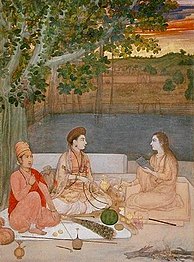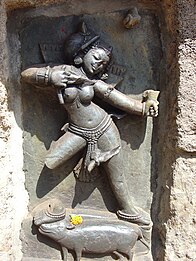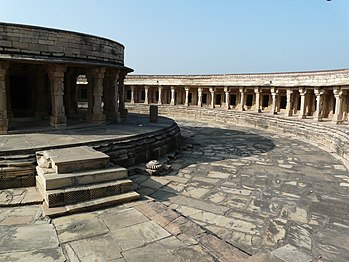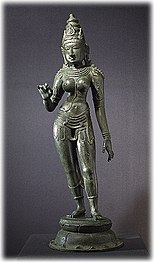Yogini
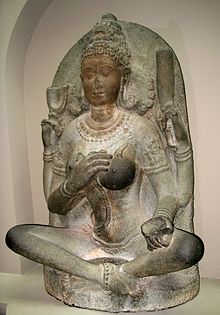
| Part ofa serieson |
| Hinduism |
|---|
 |
Ayogini(Sanskrit:योगिनी,IAST:yoginī) is a female master practitioner oftantraandyoga,as well as a formal term of respect for female Hindu or Buddhist spiritual teachers in theIndian subcontinent,Southeast AsiaandGreater Tibet.The term is the feminine Sanskrit word of the masculineyogi,while the term "yogin"IPA:[ˈjoːɡɪn]is used in neutral, masculine or feminine sense.[1]
A yogini, in some contexts, is the sacred feminine force made incarnate, as an aspect ofMahadevi,and revered in theyogini templesof India. These often revere a group of 64 yoginis, and are named as such, but can also have 42 or 81 yoginis. The names of the 64 yoginis vary in different classifications.
History
[edit]The worship of yoginis began outsideVedic Religion,starting according to Vidya Dehejia with the cults of local village goddesses, thegrama devatas.Each one protects her village, sometimes giving specific benefits such as safety from the stings ofscorpions.Gradually, throughTantra,these goddesses were grouped together into a number believed powerful, most often 64, and they became accepted as a valid part of Hinduism.[2] Historical evidence onYogini Kaulassuggests that the practice was well established by the 10th century in both Hindu and Buddhist tantra traditions.[3]The nature of the yoginis differs between the traditions; in Tantra they are fierce and scary, while in India, celibate female sanyassins may describe themselves as yoginis.[4]
Devi
[edit]In ancient and medieval texts inHinduism,a yogini is associated with or directly an aspect ofDevi,the goddess.[5]In the 11th century collection of myths, theKathāsaritsāgara,ayoginiis one of a class of females with magical powers, sorceresses sometimes enumerated as 8, 60, 64 or 65.[6]TheHatha Yoga Pradipikamentions yoginis.[7]Devi is sometimes portrayed with a superimposed Yogini Chakra, wheel of the 64 Yoginis, placing them as aspects of Devi.[8]
-
Cloth painting ofDeviwith a superimposed Yogini Chakra, wheel of the 64 Yoginis. Rajasthan, 19th century.
Nath Yoga
[edit]The termyoginihas been in use in medieval times for a woman who belongs to theNath Yogatradition founded around the 11th century.[9]They usually belong to theShaivatradition, but some Natha belong to theVaishnavatradition.[10]Either way, states David Lorenzen, they practiceYogaand their principal God tends to beNirguna,that is, without form and semi-monistic,[10]influenced in the medieval era byAdvaita VedantaHinduism,MadhyamakaBuddhism, and by Tantra.[11][12]Human yoginis were a large part of this tradition, and many 2nd-millennium paintings depict them and their Yoga practices. Lorenzen states that the Nath yogis were popular with the rural population in South Asia, with medieval era tales and stories about Nath yogis continuing to be remembered in contemporary times, in theDeccan,western and northern states of India and in Nepal.[10]
Tantra
[edit]Women inTantratraditions, whether Hindu or Buddhist, are similarly called yoginis.[13][14]InTantric Buddhism,Miranda Shawstates that many women like Dombiyogini, Sahajayogicinta, Lakshminkara, Mekhala, Kankhala Gangadhara, Siddharajni, and others, were respected yoginis and advanced seekers on the path toenlightenment.[15]
64 yoginis
[edit]Characteristics
[edit]From around the 10th century, yoginis appear in groups, often of 64. They appear as goddesses, but human female adepts oftantracan emulate "and even embody" these deities, who can appear as mortal women, creating an ambiguous and blurred boundary between the human and the divine.[16]Yoginis, divine or human, belong to clans; inShaiva,among the most important are the clans of the 8 Mothers (matris ormatrikas). Yoginis are oftentheriomorphic,having the forms of animals, represented in statuary as female figures with animal heads. Yoginis are associated with "actualshapeshifting"into female animals, and the ability to transform other people.[17]They are linked with theBhairava,often carrying skulls and other tantric symbols, and practising in cremation grounds and otherliminalplaces. They are powerful and dangerous. They both protect and disseminateesoterictantric knowledge. They havesiddhis,extraordinary powers, including the power of flight;[18]many yoginis have the form of birds or have a bird as theirvahanaor animal vehicle.[19]In later Tantric Buddhism,dakini,a female spirit able to fly, is often used synonymously with yogini.[20]The scholar Shaman Hatley writes that the archetypal yogini is "the autonomous Sky-traveller (khecari) ", and that this power is the" ultimate attainment for thesiddhi-seeking practitioner ".[21]
Into the late 20th century, yoginis inspired a "deep sense of fear and awe" among "average" people in India, according to the scholarVidya Dehejia.She notes that such fear may be ancient, as theBrahmanda Puranaand theJnanarnava Tantraboth warn that transmitting secret knowledge to non-initiates will incur the curse of the yoginis.[22]
Association with Matrikas
[edit]In Sanskrit literature, the yoginis have been represented as the attendants or manifestations ofDurgaengaged in fighting with the demonsShumbhaandNishumbha,and the principal yoginis are identified with theMatrikas.[23]Other yoginis are described as born from one or more Matrikas. The derivation of 64 yoginis from 8 Matrikas became a tradition. By the mid-11th century, the connection between yoginis and Matrikas had become common lore. Themandala(circle) andchakraof yoginis were used alternatively. The 81 yoginis evolve from a group of 9 Matrikas. The 7 Mothers or Saptamatrika (Brahmi, Maheshvari, Kaumari, Vaishnavi, Varahi, Indrani (Aindri) and Chamundi), joined byChandiand Mahalakshmi, form the nine-Matrika cluster. Each Matrika is considered to be a yogini and is associate with 8 other yoginis resulting in the troupe of 81 (9 times 9).[24]Some traditions have only 7 Matrikas, and thus fewer yoginis.
Names
[edit]There is no universally-agreed list of the names of the 64 yoginis; Dehejia located and compared some 30 different lists, finding that they rarely corresponded, and that there must have been multiple traditions concerning the 64. She states that the lists can be categorised into those that include the Matrikas among the Yoginis and give the Yoginis high status, and those that do neither. The high status means that the Yoginis are either aspects of the Great GoddessDevi,or her acolytes.[25]
TheKalika Puranaincludes 16 Matrikas among the yoginis. 9 of these Matrikas are of theBrahmiseries; Dehejia comments that in this tradition, the yoginis are "64 varying aspects of Devi herself"; they are to be worshipped "individually".[26]
TheAgni Puranadoes not include the Matrikas among the yoginis, but states that they are related. It divides the yoginis into 8 family groups, each one led by a Matrika, who is either the mother or another relative of each of her yoginis.[25]
TheAgni Purana,theSkanda Puranaand theKalika Puranaeach contain two lists (namavalis) of yoginis with often wholly differing contents. TheSri Matottara Tantratells that theKhechari Chakraand theYogini Chakraare both circles of 64 yoginis, while theMula Chakrahas a circle of 81 and theMalini Chakrahas a circle of 50.[27]The number 8 is auspicious; its square, 64, is "even more potent and efficacious".[28]In tantric texts there are supposedly 64 Agamas and Tantras, 64 Bhairavas, 64mantras,64 sites sacred to the Goddess (pithas), and 64 extraordinary powers (siddhis). Dehejia notes that the yoginis are closely associated with thesiddhis.[28]
Temples
[edit]Yogini temples are simple compared to typical Indian temples, without the usual towers, gateways and elaborate carvings that attract scholarly attention.[22]
Major extanthypaethral(open air) temples of the 64 yoginis (Chausathi Jogan)[29][23]in India built between the 9th and 12th centuries include two inOdishaatHirapurandRanipur Jharial;[30]and three inMadhya Pradesh,atKhajuraho,Bhedaghat,[31][32]and the well-preserved hilltop temple atMataoliin Morena district.[33][34]
The iconographies of the yogini statues in the various temples are not uniform, nor are the yoginis the same in each set of 64. In the Hirapur temple, all the yoginis are depicted with theirVahanas(animal vehicles) and in standing posture. In the Ranipur-Jharial temple the yogini images are in dancing posture. In the Bhedaghat temple, the yoginis are seated inlalitasana.[29]
-
Chausathi Yogini Temple, Hirapur,Odisha,2012. The yoginis have recently been venerated with the gift of headscarves.
-
One of the Yoginis of Chausathi Yogini Temple at Hirapur,Odisha.There is an offering of flowers at the yogini's feet.
-
8th-centuryChausath Yogini Temple, Morena,Madhya Pradesh
Statues
[edit]Temple images of yoginis have been made in materials including stone and bronze from at least the 9th century.
Siddhis
[edit]The goal of yogini worship, as described in bothPuranasand Tantras, was the acquisition ofsiddhis.[35]
TheSri Matottara Tantradescribes 8 major powers, as named in theYoga Sutras of Patanjali,namely:Anima,becoming microscopically small, giving knowledge of how the world works;Mahima,becoming huge, able to view the whole solar system and universe;Laghima,becoming weightless, allowing levitation and astral travel away from the body;Garima,becoming very heavy and powerful;Prakamya,having an irresistible willpower, able to control the minds of others;Ishitva,controlling both body and mind and all living things;Vashitva,controlling the natural elements, such as rain, drought, volcanoes, and earthquakes; and Kamavashayita, gaining all one's desires and any treasure.[36]
TheSri Matottara Tantralists many other more or less magical powers that devotees can obtain by invoking the yoginis correctly, from the ability to cause death, disillusion, paralysis, or unconsciousness to provocation, delightful poetry, and seduction.[37]
Practices
[edit]
Wine, flesh, blood
[edit]Yogini worship, intended to yield occult powers, consisted of a set of rituals calledMahayaga.These took place in the sacred space of the circular temple, appropriate for the working of magic. The yoginis were invoked with offerings of wine, flesh, and blood. TheSri Matottara Tantradescribes the yoginis delighting in and drunk upon wine; one of them is indeed named Surapriya (lover of wine). TheKularnava Tantraprovides a recipe for brewing the yoginis' drink, involving dry ginger, lemon bark, black pepper, blossoms, honey andjaggerysugar in water, brewed for 12 days. The yoginis danced and drank blood and wine, according to theBrhaddharma Purana.TheKaulavali Nirnayaadds that blood and meat are needed to worship the yoginis. The sacrifice of animals, always male, is practised atAssam'sKamakhya Temple,where the 64 yoginis continue to be worshipped.[38]
Corpse rituals
[edit]Sculptures at some of the yogini temples such as Shahdol,BheraghatandRanipur-Jharialdepict the yoginis withkartariknives, human corpses, severed heads, and skull-cups. There appear to have been corpse rituals,shava sadhana,as is described in theVira Tantra,which calls for offerings of food and wine to the 64 yoginis, and forpranayamato be practised while sitting on a corpse. TheVira Cudamanirequires the naked practitioner (thesadhaka) and his partner to sit on the corpse and practisemaithuna,tantric sex. TheSri Matottara Tantrainstructs that the corpse must be intact, beautiful, and fresh; Dehejia notes that this does not imply human sacrifice, but the selection of the best corpses. In the circle of the Mothers, in front of the statue of Bhairava, the corpse is to be bathed, covered in sandalwood paste, and have its head cut off in a single stroke. The Mothers will, it states, be watching this from the sky, and thesadhakawill acquire the 8 majorsiddhis.Further, flesh from the corpse is eaten; Dehejia states that the practice "is not uncommon" and that in Kamakhya, people avoid leaving a corpse overnight before cremation "for fear of losing it to tantric practitioners".[39]
Maithuna
[edit]Dehejia notes that none of the yogini temples have sculptures depictingmaithuna,ritual sex, nor are there any small figures in embrace carved into the pedestal of any yogini statue. All the same, she writes, it is "fairly certain" thatmaithunawas one of the Mahayaga rituals.[40]TheKularnava Tantramentions "the eight and the sixty-fourmithunas"(couples in embrace); and it proposes that the 64 yoginis should be portrayed" in embrace with the 64 Bhairavas "and that the resulting images should be worshipped.[40]TheJnanarnava Tantradescribes the 8 Matrikas paired off (yugma yugma) with the 8 Bhairavas.[40]
The Yogini Chakra, also called theKaulaChakra orBhairaviChakra, is formed as a circle (Chakra) of at least 8 people, with equal numbers of men and women. Dehejia writes that this meant that pairing was random rather than having people arriving in couples, and that this explained the careful sexual preparations in Kaula texts, such as anointing the body and touching its parts to stimulate both partners.Castewas ignored during suchChakra-puja(circle worship), all men being Shiva while in the circle, and all women being Devi, and the women of the lowest castes were thought the best suited to the role.[40]
Dehejia notes, too, that the need for "privacy and secrecy" given such practices readily explained the isolated hilltop locations of the yogini temples, well away from towns with "orthodoxBrahmanicalthinking favouring vegetarianism and objecting to alcohol ", let alone havingmaithunaamong the temple rituals.[40]
David Gordon White writes that the modern practice of ' "Tantric sex"' (his quotation marks) is radically different from the medieval practice.[41]
See also
[edit]- Apsara– Type of female spirit of the clouds and waters in Hindu and Buddhist culture
- Devadasi– Woman dedicated to the worship of a temple's patron god
- Vajrayogini– Tantric Buddhist female Buddha and ḍākiṇī
- Women in Hinduism– Position of women in the religious texts of Hinduism
- Yakshini– Class of nature spirits in Hindu, Buddhist, and Jain religious mythologies
- Yoga for women– Yoga as exercise for and marketed to women
References
[edit]- ^Monier-Williams, Monier."योगिन् (yogin)".Monier-Williams Sanskrit Dictionary 1899 List.Sanskrit English Dictionary with Etymology.Oxford University Press.Retrieved9 November2022.
- ^Dehejia 1986,pp. 1–10.
- ^White 2012,p. 73-75, 132-141.
- ^Dunn 2019.
- ^Dehejia 1986,pp. 19–31.
- ^Monier-Williams,Sanskrit Dictionary(1899).
- ^Feuerstein 2000,p. 350.
- ^Dehejia 1986,p. 22.
- ^White 2012,p. 8-9, 234-256, 454-467.
- ^abcLorenzen & Muñoz 2012,pp. x–xi.
- ^Lorenzen 2004,pp. 310–311.
- ^Lorenzen & Muñoz 2012,pp. 24–25.
- ^Gross 1993,pp. 87, 85–88.
- ^White 2013,pp. xiii–xv.
- ^Shaw 1994.
- ^Hatley 2007,pp. 12–13.
- ^Hatley 2007,pp. 13–14.
- ^Hatley 2007,pp. 16–17.
- ^Hatley 2007,p. 14.
- ^Hatley 2007,p. 59.
- ^Hatley 2007,p. 17.
- ^abDehejia 1986,pp. ix–x.
- ^abBhattacharyya 1996,p. 128.
- ^Wangu 2003,p. 114.
- ^abDehejia 1986,p. 187.
- ^Dehejia 1986,p. 188.
- ^Dehejia 1986,p. xi.
- ^abDehejia 1986,p. 44.
- ^abChaudhury, Janmejay (October 2004)."Origin of Tantricism and Sixty-four Yogini Cult in Orissa"(PDF).Orissa Review.Archived fromthe original(PDF)on 25 May 2010.
- ^Patel, C. B. (August 2004)."Monumental Efflorescence of Ranipur-Jharial"(PDF).Orissa Review:41–44. Archived fromthe original(PDF)on September 30, 2007.
- ^Jabalpur district official website – about usArchivedAugust 14, 2007, at theWayback Machine
- ^Chausath Yogini Temple – Site Plan, Photos and Inventory of GoddessesArchivedApril 17, 2010, at theWayback Machine
- ^"Ekattarso Mahadeva Temple".Archaeological Survey of India.Archivedfrom the original on 19 October 2017.Retrieved26 October2020.
- ^Dehejia 1986,pp. 91–144.
- ^Dehejia 1986,pp. 53–66.
- ^Dehejia 1986,pp. 53–54.
- ^Dehejia 1986,p. 54.
- ^Dehejia 1986,pp. 56–58.
- ^Dehejia 1986,pp. 58–61.
- ^abcdeDehejia 1986,pp. 62–64.
- ^White 2006,p. xiii.
Works cited
[edit]- Bhattacharyya, Narendra Nath (1996) [1974].History of the Sakta Religion(2nd ed.). Munshiram Manoharlal Publishers.ISBN978-8121507134.
- Dehejia, Vidya(1986).Yogini Cult and Temples: A Tantric Tradition.National Museum,Janpath, New Delhi.
- Dunn, Laura M. (2019). "Yoginīs in the Flesh: Power, Praxis, and the Embodied Feminine Divine".Journal of Dharma Studies.1(2). Springer: 287–302.doi:10.1007/s42240-019-00023-4.ISSN2522-0926.S2CID151147589.
- Feuerstein, Georg(2000).The Shambhala Encyclopedia of Yoga.Shambhala Publications.
- Gross, Rita (1993).Buddhism After Patriarchy.SUNY Press.ISBN978-0791414033.
- Hatley, Shaman(2007).The Brahmayāmalatantra and Early Śaiva Cult of Yoginīs.University of Pennsylvania (PhD Thesis, UMI Number: 3292099). pp. 1–459.
- Lorenzen, David (2004).Religious Movements in South Asia, 600-1800.Oxford University Press.ISBN978-0195664485.
- Lorenzen, David N.; Muñoz, Adrián (2012).Yogi Heroes and Poets: Histories and Legends of the Naths.SUNY Press.ISBN978-1438438900.
- Shaw, Miranda (1994).Passionate Enlightenment: Women in Tantric Buddhism.Princeton University Press.
- Wangu, Madhu Bazaz (2003).Images of Indian Goddesses.Abhinav Publications.ISBN978-8170174165.
- White, David Gordon(2012).The Alchemical Body: Siddha Traditions in Medieval India.University of Chicago Press.ISBN978-0226149349.
- White, David Gordon (2013).Tantra in Practice.Motilal Banarsidass.ISBN978-8120817784.
- White, David Gordon (2006) [2003].Kiss of the Yogini: 'Tantric Sex' in its South Asian Contexts.University of Chicago Press.ISBN978-0226894843.
Further reading
[edit]- Brown, Cheever Mackenzie (1998).The Devi Gita: The Song of the Goddess: A Translation, Annotation, and Commentary.SUNY Press.ISBN978-0-7914-3939-5.
- Chopra, Shambhavi (2006).Yogini: Unfolding the Goddess Within.Wisdom Tree Press.ISBN978-8183280358.
- Johnsen, Linda (1994).Daughters of the Goddess: The Women Saints of India.Yes International Publishing.ISBN978-0936663098.
- McDaniel, June (2004).Offering Flowers, Feeding Skulls: Popular Goddess Worship in West Bengal.Oxford University Press.ISBN978-0-19-534713-5.
External links
[edit]![]() Media related toYoginiat Wikimedia Commons
Media related toYoginiat Wikimedia Commons



